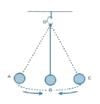Olympiad Test: Motion And Measurement Of Distances - Class 6 MCQ
20 Questions MCQ Test - Olympiad Test: Motion And Measurement Of Distances
Movement of a branch of a tree in air is an example of _________.
Which of the following statements is correct?
Who found that a pendulum of a given length always takes the same time to complete one oscillation?
The scale should be kept _______ the length while measuring a length.
When the bob of the pendulum is released after taking it slightly to one side, it:
The motion of a rolling ball is an example of ________ motion.
Identify the types of motion from the images below.

Three cars are running on the road with three different speeds: 78 mph, 59 mph, and 65 mph respectively. Calculate the average of these three speeds.
What would be the best unit to use to measure the tip of your pencil?
Look at the following picture carefully.
Now read the following paragraph carefully and fill the blank with correct sequence of words.
A stone suspended with a non-stretchable thread makes a simple ________. When the pendulum is at rest, it is at position B. This is called the rest position or its ________. When it swings, it moves from B to A, back to B, from B to C and back to B. This completes one full swing of the pendulum. Each swing is called __________.

Two athletes take part in two separate races and cover different distances in different times. Kavya runs 2 km in 10 minutes and Yamini runs 5 km in 20 minutes on two different tracks. Which of the following statements is correct?
Which of the following is not a unit of speed?
Look at the picture carefully: Fill in the blanks using words: stationary, moving.

The potter at the railway station is _______ in relation to the train, but is_________ in relation to the bag on his head.
Why is measurement important to us?
Read the following two paragraphs. Analyze the situation and choose the correct options.
1. A bus runs from Kolkata to Guwahati. It covers a distance of 400 km in 7 hours and then a distance of 550 km in the next 7 hours.
2. Alisha takes part in a car race. She drives a distance of 70 km each in the first,second and third hours.
Which of the following objects can be used for measuring the length of a curved line?
While reading an instrument, why is it important to place the eye in line with the reading?
In 1790, the French created a standard unit measurement called
The standard unit of length in the International System of Units (SI) is:














